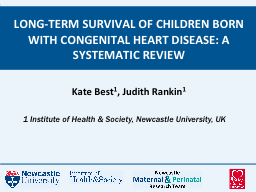PPT-Kate Best 1 , Judith Rankin
Author : samantha | Published Date : 2023-05-27
1 Longterm survival of children born with congenital heart disease a systematic review 1 Institute of Health amp Society Newcastle University UK Background Objectives
Presentation Embed Code
Download Presentation
Download Presentation The PPT/PDF document "Kate Best 1 , Judith Rankin" is the property of its rightful owner. Permission is granted to download and print the materials on this website for personal, non-commercial use only, and to display it on your personal computer provided you do not modify the materials and that you retain all copyright notices contained in the materials. By downloading content from our website, you accept the terms of this agreement.
Kate Best 1 , Judith Rankin: Transcript
Download Rules Of Document
"Kate Best 1 , Judith Rankin"The content belongs to its owner. You may download and print it for personal use, without modification, and keep all copyright notices. By downloading, you agree to these terms.
Related Documents














